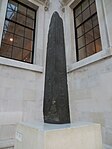Hoa Hakananai'a
1868 in Easter Island1869 in EnglandArtefacts from Africa, Oceania and the Americas in the British MuseumChile–United Kingdom relationsEaster Island ... and 5 more
Ethnographic objects in the British MuseumOceanian sculpturePolynesian cultureSculpturesSculptures of the British Museum

Hoa Hakananai'a is a moai, a statue from Easter Island. It was taken from Orongo, Easter Island (Rapa Nui) in 1868 by the crew of a British ship and is now in the British Museum in London. It has been described as a "masterpiece" and among the finest examples of Easter Island sculpture. Though relatively small, it is considered to be typical of the island's statue form, but distinguished by carvings added to the back, associated with the island's birdman cult.
Excerpt from the Wikipedia article Hoa Hakananai'a (License: CC BY-SA 3.0, Authors, Images).Hoa Hakananai'a
Great Russell Street, London Bloomsbury (London Borough of Camden)
Geographical coordinates (GPS) Address Nearby Places Show on map
Geographical coordinates (GPS)
| Latitude | Longitude |
|---|---|
| N 51.5199 ° | E -0.1274 ° |
Address
British Museum
Great Russell Street
WC1B 3DG London, Bloomsbury (London Borough of Camden)
England, United Kingdom
Open on Google Maps









